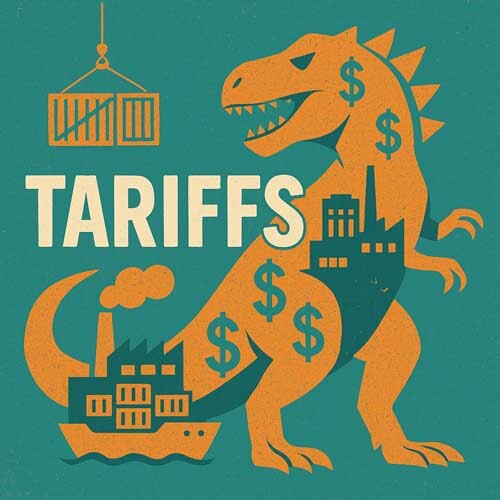News Staff![]() Nov 4
Nov 4
718 views 0 Comments 0 Likes

Tariff-o-Saurus: The Tax That Pretends It Isn’t
Tariffs are taxes with better branding. They’re collected at the docks by U.S. Customs, rolled into the importer’s cost, and—like a stubborn beach ball—pushed right back under your arm at checkout. The Treasury gets the cash, businesses juggle the math, and households feel it in the receipt line. Why do we still buy from China or Europe? Because when global supply chains hum, imports are often cheaper, sometimes better, and frequently the only way to get all the parts on time. When we try to make everything at home, costs climb, some local jobs pop up, but the national shopping cart gets heavier. That’s the trade-off in one sentence.
To keep it simple, imagine a typical household basket of imported goods—a smartphone, laptop, television, washer, furniture, clothes, and a car with foreign parts. The import value runs about $10,100. Add a 10 percent tariff, and the annual bill climbs roughly $1,010. At 25 percent, it jumps to $2,525. The car alone drives more than half that cost, since auto manufacturing is a global parts puzzle.
So what’s the upside? The Treasury loves tariffs—they bring in billions without Congress having to raise income taxes. Some American factories get breathing room to invest, and strategic sectors like chips, batteries, and medical gear can build life rafts closer to home. But economics plays the long game: raising import costs raises consumer prices, cools demand, and trims growth unless productivity jumps to offset it. “Made in USA” feels good, but it’s pricey unless we pair it with automation, energy efficiency, and scale. That’s where AI stops being a buzzword and starts cutting defects, predicting downtime, and squeezing waste from production.
The MAGA movement treats tariffs as armor for American manufacturing—a rallying cry for reclaiming jobs and industrial independence. The world economy, however, runs on cooperation. Tariffs can buy time to rebuild supply chains, but left in place forever, they become a permanent consumption tax with a patriotic label. The smart move is to use them as scaffolding, not architecture—temporary support while America rewires its production lines.
Still, tariffs have their uses. The revenue—about $25 billion a month this year—could modernize ports, strengthen the power grid, or fund small-business automation grants. AI-driven manufacturing can close the price gap between domestic and imported goods if we invest it wisely. Think of tariffs not as the cure but as the caffeine shot that keeps the economy awake while we fix the system.
In the end, tariffs are a tax in work boots. They can protect jobs for a while, but without innovation, you’ll just end up paying more for the same toaster. Used wisely, they buy America time to get more efficient. Used endlessly, they’re just another bill you didn’t vote for—but still pay.

At Desert Local News, connections are everything. We're not just another social networking platform—we're a lively hub where people from all walks of life come together to share stories, spark ideas, and grow together. Here, creativity flourishes, communities grow stronger, and conversations spark global awareness.
Comments